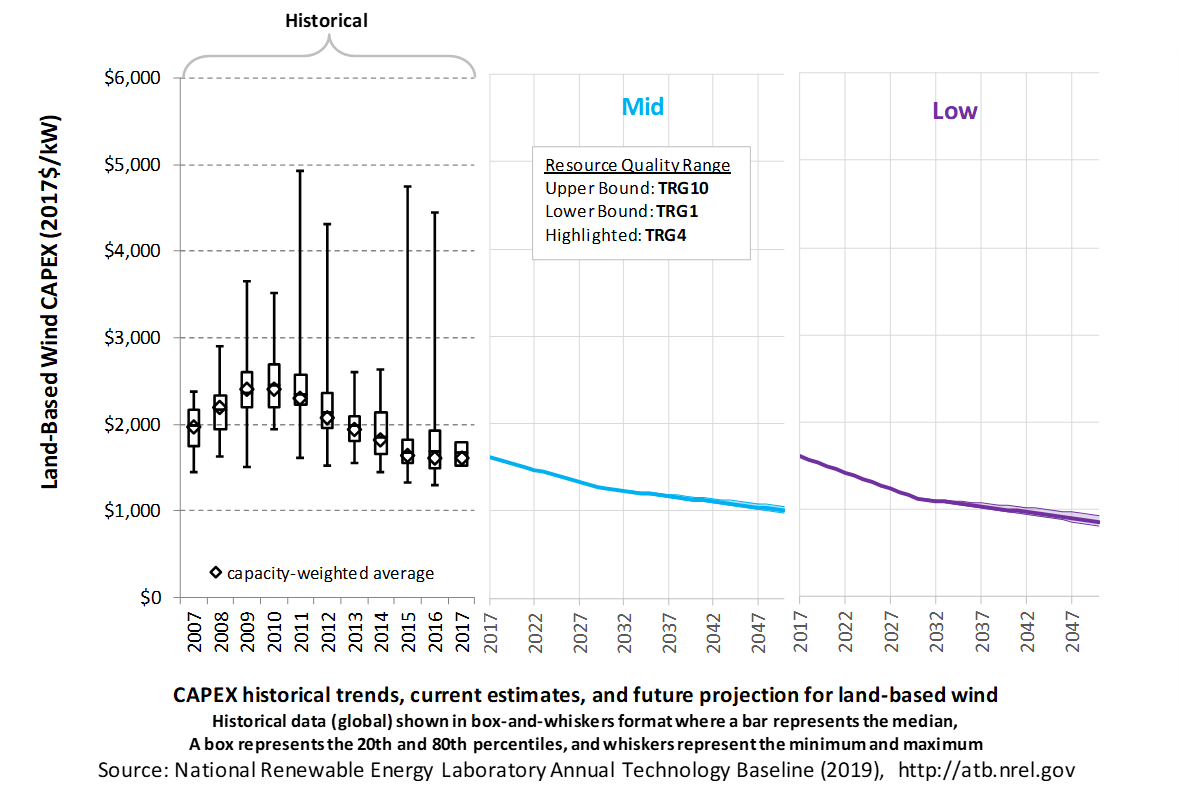Land-Based Wind
Capital Expenditures (CAPEX): Historical Trends, Current Estimates, and Future Projections
Capital expenditures (CAPEX) are expenditures required to achieve commercial operation in a given year. These expenditures include the wind turbine, the balance of system (e.g., site preparation, installation, and electrical infrastructure), and financial costs (e.g., development costs, onsite electrical equipment, and interest during construction) and are detailed in CAPEX Definition. In the ATB, CAPEX reflects typical plants and does not include differences in regional costs associated with labor, materials, taxes, or system requirements. The related Standard Scenarios product uses Regional CAPEX Adjustments. The range of CAPEX demonstrates variation with wind resource in the contiguous United States.

The CAPEX improvements for future land-based wind projects may be realized through many technology pathways to achieve LCOE reductions. It is also important to note that CAPEX improvements are not the only pathway to LCOE reductions as LCOE is also influenced by capacity factor, financing, O&M, and project life. For the purpose of reducing the vast combinations of future pathways NREL analysts defined a single future turbine configuration in 2030 to conduct the bottom-up cost analysis for the Mid and Low scenarios. The specific 2030 turbine configuration for the Mid scenario assumes a nameplate capacity of 4.5 MW with a rotor diameter of 167 m placed on a 110 m tower. Additional turbine configurations explored that resulted in LCOEs that were within 10% (or less) of the current Mid scenario included turbines with nameplate capacity ratings of 3-MW and 4-MW, rotor diameters down to 150 m, and hub heights up to 140 m. The relatively low sensitivity of LCOE to these changes in turbine configuration is indicative of the array potential pathways and solutions to the LCOE values estimated in this year's ATB.
The defined turbine characteristics were then used to estimate the total system CAPEX of a theoretical commercial scale (e.g., 100-MW) project. Although the relatively low observed sensitivity to significantly different turbine configurations for a single reference site indicate some uncertainty need for and value of wind turbine tailoring for varied site conditions, it is generally expected that over the long-term wind turbine designs will be optimized for a specific plant's site conditions. In this year's ATB, this site-specific design optimization process which is often reflected in different CAPEX values across TRGs was not included. Instead we assumed the single turbine configuration across all 10 TRGs. This simplification was applied due to limited resources and lack of necessary data to robustly characterize CAPEX variation across the 10 TRGs. Nevertheless, the ability to assess and tailor turbine configurations and CAPEX estimates for each TRG is expected to be reimplemented in future iterations of the ATB.
